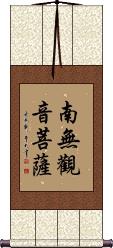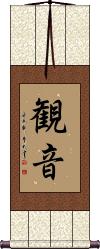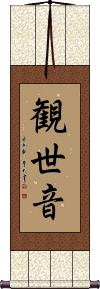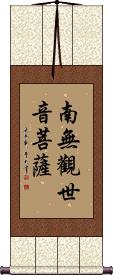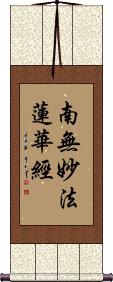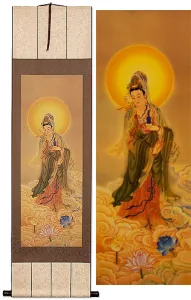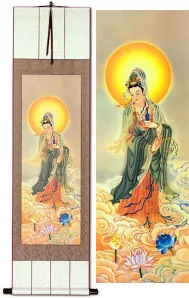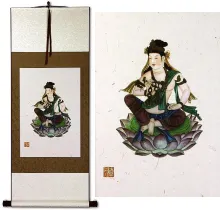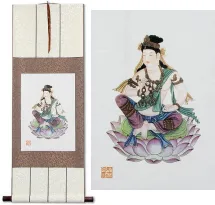Many custom options...
And formats...

Guanyin in Chinese / Japanese...
Buy a Guanyin calligraphy wall scroll here!
Personalize your custom “Guanyin” project by clicking the button next to your favorite “Guanyin” title below...
Namo Guanyin Pusa
Goddess of Compassion
観音 is the specifically Japanese version of Bodhisattva of Compassion or Guan Yin.
In Japanese, this is pronounced Kannon and occasionally spelled Kwannon. The Chinese version is a bit more commonly seen in Asia. However, in Japanese, there is a slight variation with the first character.
Some time ago, a camera company in Japan named their company after this Buddhist deity. That camera company is still known as Canon (they chose a “C” instead of a “K” when they Romanized this name).
Goddess of Compassion
Long or more formal Japanese version of this title
観世音 is the more extended and more formal Japanese version of Bodhisattva of Compassion or Guan Yin.
In Japanese, this is pronounced Kanzeon. The Chinese version is a bit more common in Asia, but in Japanese, they use a slight variation of the first character. Choose this version only if your intended audience is specifically Japanese.
Goddess of Mercy and Compassion
觀音/観音 is the Buddhist deity known as the Goddess of Mercy or Bodhisattva of Compassion.
In Chinese, the proper name of this being is Guan Yin. There is some debate as to whether Guan Yin is female. The argument comes from some scripture that suggests Buddhist deities take on the male form. Others say that Guan Yin has no sex. And still, others are okay with the female representation of Guan Yin.
This bodhisattva is also known or Romanized in the following ways:
Mandarin Chinese: Guan Yin, Kuan Yin, Kwan Yin.
Japanese: Kannon, Kwannon.
Sanskrit: Bodhisattva Avalokitesvara.
Korean: Gwan-eum.
Vietnamese: Quan Âm.
Thai: Kuan Eim.
English: Bodhisattva of Mercy and Salvation, Goddess of Compassion, Buddha of Mercy, et al.
Note: The first character has a slight variation in Japanese. If your audience is specifically Japanese, you may want to select that version.
See Also: Buddhism | Goddess | Namo Amitabha | Bodhisattva
Namo Guanshiyin Pusa
Guan Shi Yin: Protector Of Life
Namu Myoho Renge Kyo / Homage to Lotus Sutra
南無妙法蓮華經 is sometimes translated as the “Devotion to the Law of the Lotus Flower Scripture.”
This is a meditation chant and homage to the Lotus Sutra, used by Nichiren Buddhists in Japan.
This is also a chant used in China by certain sects of Buddhism that celebrate the deity Guanyin.
Also romanized as “Nam Myōhō Renge Kyō” or without accents as “Nam Myoho Renge Kyo.”
Original
Traditional
Version
The last character was originally written as seen on the left. Sometimes, you will see it written in the Japanese variant form as shown on the right. If you want this Japanese variant, click on the "Modern Japanese Variant" text instead of the button up by the main title of this entry.
This in-stock artwork might be what you are looking for, and ships right away...
Gallery Price: $200.00
Your Price: $69.88
Gallery Price: $200.00
Your Price: $69.88
Not the results for guanyin that you were looking for?
Below are some entries from our dictionary that may match your guanyin search...
| Characters If shown, 2nd row is Simp. Chinese |
Pronunciation Romanization |
Simple Dictionary Definition |
索 see styles |
suǒ suo3 so soo; sou / soo; so ソー; ソウ |
More info & calligraphy: Soe(counter) {mahj} counter for bamboo tiles; (given name) Saku Cord; to extort, express; the cord or noose of Guanyin by which she binds the good; the cord of the vajra-king by which he binds the evil; translit. sa. |
救世 see styles |
jiù shì jiu4 shi4 chiu shih kyuusei; guze; kuse / kyuse; guze; kuse きゅうせい; ぐぜ; くせ |
More info & calligraphy: Salvationsalvation To save the world; a saviour of the world, i.e. 救世者 or 救世尊; 救世菩薩 Buddhas and bodhisattvas as world-saviours, especially 救世觀世音 Guanyin, also called 救世圓滿 complete saviour of the world. |
観音 see styles |
mine みね |
More info & calligraphy: Goddess of Compassion |
観世音 see styles |
kanzenon かんぜのん |
More info & calligraphy: Goddess of Compassion |
觀世音 观世音 see styles |
guān shì yīn guan1 shi4 yin1 kuan shih yin Kanzeon かんぜおん |
More info & calligraphy: Guan Shi Yin: Protector Of Life(out-dated kanji) Avalokiteshvara (Bodhisattva); Avalokitesvara; Kannon; Kwannon; Guanyin; Buddhist deity of compassion Regarder of the world's sounds, or cries, the so-called Goddess of Mercy; also known as 觀音; 觀世音善薩; 觀自在 (觀世自在); 觀尹; 光世音 (the last being the older form). Avalokiteśvara, v. 阿 8. Originally represented as a male, the images are now generally those of a female figure. The meaning of the term is in doubt; it is intp. as above, but the term 觀自在 (觀世自在) accords with the idea of Sovereign Regarder and is not associated with sounds or cries. Guanyin is one of the triad of Amida, is represented on his left, and is also represented as crowned with Amida; but there are as many as thirty-three different forms of Guanyin, sometimes with a bird, a vase, a willow wand, a pearl, a 'thousand' eyes and hands, etc., and, when as bestower of children, carrying a child. The island of Putuo (Potala) is the chief centre of Guanyin worship, where she is the protector of all in distress, especially of those who go to sea. There are many sūtras, etc., devoted to the cult, but its provenance and the date of its introduction to China are still in doubt. Chapter 25 of the Lotus Sūtra is devoted to Guanyin, and is the principal scripture of the cult; its date is uncertain. Guanyin is sometimes confounded with Amitābha and Maitreya. She is said to be the daughter of king Śubhavyūha 妙莊王, who had her killed by 'stifling because the sword of the executioner broke without hurting her. Her spirit went to hell; but hell changed into paradise. Yama sent her back to life to save his hell, when she was miraculously transported on a Lotus flower to the island of Poo-too'. Eitel. |
九曜 see styles |
jiǔ yào jiu3 yao4 chiu yao kuyou / kuyo くよう |
(surname) Kuyou 九執 q.v. Navagraha. The nine luminaries: 日 Āditya, the sun; 月 Sōma, the moon; the five planets, i.e. 火星 Aṅgāraka, Mars; 水 Budha, Mercury; 木 Bṛhaspati, Jupiter; 金 Sukra, Venus; and 土 Śanaiścara, Saturn; also 羅睺 Rāhu, the spirit that causes eclipses; and 計都 Ketu, a comet. Each is associated with a region of the sky and also with a bodhisattva, etc., e.g. the sun with Guanyin, Venus with Amitābha, etc. |
何耶 see styles |
hé yé he2 ye2 ho yeh Kaya |
Haya, the horse-head form of Guanyin. |
十二 see styles |
shí èr shi2 er4 shih erh tooji とおじ |
twelve; 12 12; twelve; (given name) Tooji dvātriṃśa. Thirty-two. 三十二應 (or 三十二身) The thirty-two forms of Guanyin, and of Puxian, ranging from that of a Buddha to that of a man, a maid, a rakṣas; similar to the thirty-three forms named in the Lotus Sūtra. 三十二相三十二大人相 dvātriṃśadvaralakṣaṇa. The thirty-two lakṣaṇas, or physical marks of a cakravartī, or 'wheel-king', especially of the Buddha, i. e. level feet, thousand-spoke wheel-sign on feet, long slender fingers, pliant hands and feet, toes and fingers finely webbed, full-sized heels, arched insteps, thighs like a royal stag, hands reaching below the knees well-retracted male organ, height and stretch of arms equal, every hair-root dark coloured, body hair graceful and curly, golden-hued body, a 10 ft. halo around him, soft smooth skin, the 七處, i. e. two soles, two palms, two shoulders, and crown well rounded, below the armpits well-filled, lion-shaped body, erect, full shoulders, forty teeth, teeth white even and close, the four canine teeth pure white, lion-jawed, saliva improving the taste of all food, tongue long and broad, voice deep and resonant, eyes deep blue, eyelashes like a royal bull, a white ūrnā or curl between the eyebrows emitting light, an uṣṇīṣa or fleshy protuberance on the crown. These are from the 三藏法數 48, with which the 智度論 4, 涅盤經 28, 中阿含經, 三十ニ相經 generally agree. The 無量義經 has a different list. 三十二相經 The eleventh chapter of the 阿含經. 三十二相經願 The twenty-first of Amitābha's vows, v. 無量壽經. 三十三 trayastriṃśat. Thirty-three. 三十三天忉利天; 憺梨天, 多羅夜登陵舍; 憺利夜登陵奢; 憺利耶憺利奢 Trayastriṃśas. The Indra heaven, the second of the six heavens of form. Its capital is situated on the summit of Mt. Sumeru, where Indra rules over his thirty-two devas, who reside on thirty-two peaks of Sumeru, eight in each of the four directons. Indra's capital is called 殊勝 Sudarśana, 喜見城 Joy-view city. Its people are a yojana in height, each one's clothing weighs 六鐵 (1; 4 oz. ), and they live 1, 000 years, a day and night being equal to 100 earthly years. Eitel says Indra's heaven 'tallies in all its details with the Svarga of Brahminic mythology' and suggests that 'the whole myth may have an astronomical meaning', or be connected, with 'the atmosphere with its phenomena, which strengthens Koeppen's hypothesis explaining the number thirty-three as referring to the eight Vasus, eleven Rudras, twelve Ādityas, and two Aśvins of Vedic mythology'. In his palace called Vaijayanta 'Indra is enthroned with 1, 000 eyes with four arms grasping the vajra. There he revels in numberless sensual pleasures together with his wife Śacī... and with 119, 000 concubines with whom he associates by means of transformation'.; dvādaśa, twelve. |
千手 see styles |
qiān shǒu qian1 shou3 ch`ien shou chien shou chihira ちひら |
(female given name) Chihira (千手千眼); 千手千眼大慈大悲觀音菩薩 The thousand-hand Guanyin, see below. There are various sutras associated with this title, e.g. 千手經 an abbreviation of 手千眼觀世音菩薩大廣大圓滿無礙大悲心陀羅尼經; also 千手軌 or 軌經 an abbreviation of 金剛頂瑜伽千手千眼觀自在菩薩修行儀軌經; it is also called 千手陀羅尼 and 千手千眼儀軌經; there are many others, e.g. 千手千眼觀世音菩藤姥陀羅尼身經 and 千手千眼廣大圓滿無礙大悲心陀羅尼經 both idem 千手千臂陀羅尼神咒 which is the Avalokiteśvara-padma-jāla-mūla-tantra‐nāma-dhāraṇī. |
大悲 see styles |
dà bēi da4 bei1 ta pei karuna かるな |
(female given name) Karuna mahākaruṇā, "great pity"; i.e. greatly pitiful, a heart that seeks to save the suffering; applied to all Buddhas and bodhisattvas; especially to Guanyin. |
大梵 see styles |
dà fàn da4 fan4 ta fan daibon |
Mahābrāhmaṇas; the third Brahmaloka, the third region of the first dhyāna. Mahābrahman; the great Brahma, 大梵天; it is also a title of one of the six Guanyin of the Tiantai sect. |
妙見 妙见 see styles |
miào jiàn miao4 jian4 miao chien myouken / myoken みょうけん |
(place-name, surname) Myōken The beautiful sight, i.e. Ursa Major, or the Bodhisattva who rules there, styled 妙見大士 (or 妙見菩薩), though some say Śākyamuni, others Guanyin, others 藥師 Bhaiṣajya, others the seven Buddhas. His image is that of a youth in golden armour. |
妙音 see styles |
miào yīn miao4 yin1 miao yin myouon / myoon みょうおん |
exquisite voice; exquisite music; (place-name) Myōon Wonderful sound. (1) Gadgadasvara, 妙音菩薩 (or 妙音大士) a Bodhisattva, master of seventeen degrees of samādhi, residing in Vairocanaraśmi-pratimaṇḍita, whose name heads chap. 24 of the Lotus Sutra. (2) Sughoṣa, a sister of Guanyin; also a Buddha like Varuṇa controlling the waters 水天德佛, the 743rd Buddha of the present kalpa. (3) Ghoṣa, 瞿沙 an arhat, famous for exegesis, who "restored the eyesight of Dharmavivardhana by washing his eyes with the tears of people who were moved by his eloquence." Eitel. |
悲智 see styles |
bēi zhì bei1 zhi4 pei chih hichi |
Pity and wisdom; the two characteristics of a bodhisattva seeking to attain perfect enlightenment and the salvation of all beings. In the esoteric sects pity is represented by the Garbadhātu or the womb treasury, while wisdom is represented by the Vajradhātu, the diamond treasury. Pity is typified by Guanyin, wisdom by Mahāsthāmaprāpta, the two associates of Amitābha. |
懺法 忏法 see styles |
chàn fǎ chan4 fa3 ch`an fa chan fa senbou / senbo せんぼう |
(1) {Buddh} penitence by chanting sutras; confession (of sins); Tendai ritual of chanting Lotus Sutra or to Kanzeon, Amida, or Kichijoten for forgiveness of sins performed unknowingly; (n,n-suf) (2) {Buddh} penitence sutra; (3) {Buddh} guidebook to penitence The mode of action, or ritual, at the confessional; also the various types of confessional, e.g. that of Guanyin, Amitābha, etc. |
戴塔 see styles |
dài tǎ dai4 ta3 tai t`a tai ta taitō |
To have a pagoda represented on the head, as in certain images; a form of Maitreya, āryastūpa-mahāśrī, 戴塔吉祥; also applied to Guanyin, etc. |
授手 see styles |
shòu shǒu shou4 shou3 shou shou jushu |
To proffer the hand, to come in person to welcome the dying, as e.g. does Guanyin in certain cases. |
日天 see styles |
rì tiān ri4 tian1 jih t`ien jih tien nitten にってん |
(1) {Buddh} (See 日天子・1) Surya (Hindu sun god also revered as one of the twelve devas in Shingon Buddhism); (2) (archaism) sun; (given name) Nitten (日天子) sūrya, 蘇利耶; 修利; 修野天子 (or 修意天子) 天子; also 寳光天子. The sun-ruler; one of the metamorphoses of Guanyin, dwelling in the sun as palace, driving a quadriga. |
月蓋 月盖 see styles |
yuè gài yue4 gai4 yüeh kai Gatsugai |
An elder of Vaiśālī, who at the Buddha's bidding sought the aid of Amitābha, 勢至 (Mahāsthamaprāpta) and Guanyin, especially the last, to rid his people of a pestilence. See Vimalakīrti Sutra. |
本迹 see styles |
běn jī ben3 ji1 pen chi honjaku |
The original 本 Buddha or Bodhisattva and his 迹 varied manifestations for saving all beings, e. g. Guanyin with thirty-three forms. Also 本地垂迹. |
法殿 see styles |
fǎ diàn fa3 dian4 fa tien hōden |
The temple, or hall, of the Law, the main hall of a monastery; also the Guanyin hall. |
準提 准提 see styles |
zhǔn tí zhun3 ti2 chun t`i chun ti Juntei |
Candī, or Cundi; also 准胝; 尊提. (1) In Brahmanic mythology a vindictive form of Durgā, or Pārvatī, wife of Śiva. (2) In China identified with Marīci 摩里支 or 天后 Queen of Heaven. She is represented with three eyes and eighteen arms; also as a form of Guanyin, or in Guanyin's retinue. |
玉環 玉环 see styles |
yù huán yu4 huan2 yü huan tamaki たまき |
Yuhuan county in Taizhou 台州[Tai1 zhou1], Zhejiang (female given name) Tamaki The Jade ring in one of the right hands of the 'thousand-hand' Guanyin. |
白衣 see styles |
bái yī bai2 yi1 pai i hakui(p); byakue; byakui; hakue; shirokinu; shiroginu はくい(P); びゃくえ; びゃくい; はくえ; しろきぬ; しろぎぬ |
(1) white clothes; white robe; (2) (はくい only) white gown (worn by doctors, chemists, etc.); (3) (はくい, はくえ only) (hist) commoner without rank (in ancient China); (4) (びゃくえ, はくえ, しろきぬ, しろぎぬ only) (ant: 緇衣・しえ・2) layperson White clothing, said to be that of Brahmans and other people, hence it and 白俗 are terms for the common people. It is a name also for Guanyin. |
紇哩 纥哩 see styles |
hé lī he2 li1 ho li kiriku |
or 紇利 (紇利倶); 纈利 hrīḥ is a germ-word of Amitābha and Guanyin. |
莊王 庄王 see styles |
zhuāng wáng zhuang1 wang2 chuang wang Shōō |
v. 妙 Śubhavyūha, reputed father of Guanyin. |
補陀 补陀 see styles |
bǔ tuó bu3 tuo2 pu t`o pu to hoda ほだ |
(surname) Hoda 補陁; 補陀落 (補陀落迦) Potala; Potalaka. (1) A sea-port on the Indus, the παταλα of the ancients, identified by some with Thaṭtha, said to be the ancient home of Śākyamuni's ancestors. (2) A mountain south-east of Malakūṭa, reputed as the home of Avalokiteśvara. (3) The island of Pootoo, east of Ningpo, the Guanyin centre. (4) The Lhasa Potala in Tibet; the seat of the Dalai Lama, an incarnation of Avalokiteśvara; cf. 普; also written補怛落迦 (or 補但落迦); 逋多 (逋多羅); 布呾洛加. |
觀音 观音 see styles |
guān yīn guan1 yin1 kuan yin kanon かんおん |
Guanyin, the Bodhisattva of Compassion or Goddess of Mercy (Sanskrit Avalokiteśvara) (out-dated kanji) Avalokiteshvara (Bodhisattva); Avalokitesvara; Kannon; Kwannon; Guanyin; Buddhist deity of compassion; (personal name) Kan'on Guanyin |
軍持 军持 see styles |
jun chí jun1 chi2 chün ch`ih chün chih gunji ぐんじ |
(1) {Buddh} water bottle (of a monk, nun, etc.); flask; (2) (archaism) vase Kuṇḍi, Guanyin with the vase, also 軍M040652 (or 鍕M040652); 運M063616; 君持; 君遲; also 君稚迦 (or 捃稚迦) for Kuṇḍikā, idem. 君持 and 君遲 are also used for kuḍikā, an ascetic's water-bottle. |
隨求 随求 see styles |
suí qiú sui2 qiu2 sui ch`iu sui chiu Zuigu |
According to prayer. Name of a deva who was formerly a wicked monk who died and went to hell, but when dying repented, prayed, and was reborn the deva 隨求天子 or 隨求卽得天子. Also, a bodhisattva in the Guanyin group of the Garbhadhātu, a metamorphosis of Guanyin, who sees that all prayers are answered, 隨求菩薩. |
Click here for more guanyin results from our dictionary
The following table may be helpful for those studying Chinese or Japanese...
| Title | Characters | Romaji (Romanized Japanese) | Various forms of Romanized Chinese | |
| Namo Guanyin Pusa | 南無觀音菩薩 南无观音菩萨 | namu kannon bosatsu namukannonbosatsu | nán wú guàn yīn pú sà nan2 wu2 guan4 yin1 pu2 sa4 nan wu guan yin pu sa nanwuguanyinpusa | nan wu kuan yin p`u sa nanwukuanyinpusa nan wu kuan yin pu sa |
| Goddess of Compassion | 観音 | kan non / kannon | guān yīn / guan1 yin1 / guan yin / guanyin | kuan yin / kuanyin |
| Goddess of Compassion | 観世音 | kan ze on / kanzeon | guān shì yīn guan1 shi4 yin1 guan shi yin guanshiyin | kuan shih yin kuanshihyin |
| Goddess of Mercy and Compassion | 觀音 / 観音 观音 | kan non / kannon | guān yīn / guan1 yin1 / guan yin / guanyin | kuan yin / kuanyin |
| Namo Guanshiyin Pusa | 南無觀世音菩薩 南无观世音菩萨 | namu kanzeon bosatsu namukanzeonbosatsu | nán wú guān shì yīn pú sà nan2 wu2 guan1 shi4 yin1 pu2 sa4 nan wu guan shi yin pu sa nanwuguanshiyinpusa | nan wu kuan shih yin p`u sa nanwukuanshihyinpusa nan wu kuan shih yin pu sa |
| Guan Shi Yin: Protector Of Life | 觀世音 观世音 | kanzeon | guān shì yīn guan1 shi4 yin1 guan shi yin guanshiyin | kuan shih yin kuanshihyin |
| Namu Myoho Renge Kyo Homage to Lotus Sutra | 南無妙法蓮華經 / 南無妙法蓮華経 南无妙法莲华经 | na mu myou hou ren ge kyou namumyouhourengekyou na mu myo ho ren ge kyo | nán wú miào fǎ lián huá jīng nan2 wu2 miao4 fa3 lian2 hua2 jing1 nan wu miao fa lian hua jing nanwumiaofalianhuajing | nan wu miao fa lien hua ching nanwumiaofalienhuaching |
| In some entries above you will see that characters have different versions above and below a line. In these cases, the characters above the line are Traditional Chinese, while the ones below are Simplified Chinese. | ||||
Successful Chinese Character and Japanese Kanji calligraphy searches within the last few hours...
